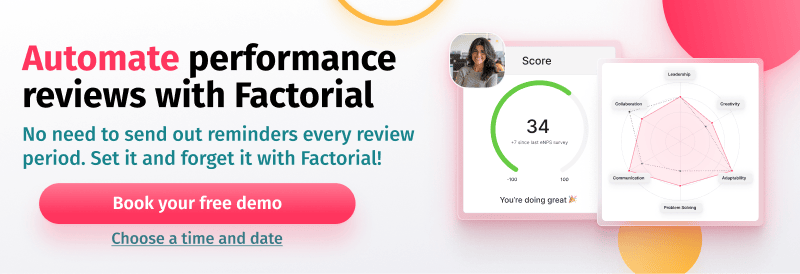Constructive feedback is vital to employee development. It helps your employees understand what your performance expectations are, and it also helps you align your workforce with your overall business objectives. That’s why it’s so important to have an established system in place for measuring performance, including regular employee performance reviews and effective competency assessment procedures.
However, this isn’t always easy.
In today’s post, we are going to share everything you need to know about performance reviews and competency assessments. We will look at what they are, how they differ, and the pros and cons of both evaluation methods. We will also discuss how using the right employee performance software can help you create an effective performance management process for the good of your business.
- Why conduct performance reviews?
- 5 ways of measuring employee performance & examples
- What questions should you ask during performance reviews?
- Sample of employee performance review questions
- Performance review questions for managers
- Performance reviews and competency assessments: similarities & differences
- Types of competency assessments
- Benefits of competency assessments
- Downsides of competency assessments
- Tracking employee performance with Factorial
- Defining and assessing competencies with Factorial
- ✅ Streamline your performance management process with software
Why conduct performance reviews?
Employee performance management is an essential HR tool that helps you get the most from your workforce. The right approach helps you keep your employees motivated, valued, and productive.
According to a recent study by Deloitte, only 8% of companies believe that their current performance management process drives high levels of value, and 58% claim that it is not an effective use of their time. Unless you design and implement an effective system for measuring performance, you risk alienating high performers, damaging employee engagement, and wasting valuable time and resources.
Before we discuss how to measure employee performance effectively, let’s look at some of the specific benefits of conducting regular employee performance reviews.
- Performance reviews help you align employee performance with your expectations and the specific strategic objectives of your business.
- Performance reviews also enable you to identify and address potential performance gaps before they have a negative impact on the overall productivity of your business.
- Sharing constructive feedback gives employees a clear sense of direction. Moreover, the right feedback can help them develop professionally and expand their skill set.
- Conducting regular performance appraisals can be a great tool to motivate your workforce and raise employee morale. This is because when employees understand how their performance impacts the business, they have a structured incentive to work harder and continuously improve.
- Offering two-way feedback helps your workforce feel valued and heard. This boosts employee engagement and satisfaction levels. It also helps you nurture an inclusive working environment.
- If you use performance management software to manage your reviews, you get access to all the tools you need to manage performance reviews for remote employees. That way, you can maintain open lines of communication with employees who you don’t see regularly. You can also use these reviews to identify if remote employees need any extra support, resources, or training to help them meet their performance objectives.
- Finally, regular performance reviews help you nurture a culture of open dialogue. This helps you build an organization based on trust and transparency.
5 ways of measuring employee performance & examples
Let’s begin by pointing out that there is no one “right way” of evaluating and managing employee performance. The truth is, many businesses adopt several models. After all, the more information and data available, the better off you are.
Here are some different tactics that many businesses implement to have a well-rounded understanding of their team’s efforts.
Use a 9-box grid for performance reviews
A 9-box grid is a performance management tool that allows employers to consider and evaluate employee performance and potential. Essentially, it is a 3×3 square chart (9 boxes total) with the x-axis representing potential and the y-axis representing performance. During evaluations, employees receive a numerical score for their potential and performance. Then, managers plot these scores onto the 9-box grid.
Afterward, employers look into the specific archetypes that define employees based on their 9-box results. Those who receive both high performance and potential scores are star employees who often advance up the career ladder fairly quickly. Whereas those who have high performance but low potential are so-called workhorses that might be well-placed in their current position.
9-box charts are an excellent way for employers to make sure that employees are a good fit for their given roles. And, they can be especially effective when used in tandem with career pathing tools, like Factorial’s OKR software, to ensure that employees are fulfilling their long-term professional development objectives.
360-degree feedback during performance reviews
360-degree feedback is a way of measuring employee performance in which an employee’s manager, peers, direct reports, and customers provide feedback. This is not to be confused with 180-degree feedback, in which only an employee’s manager and colleagues are part of the process.
Having more participation provides employers with a wider range of information and a more comprehensive understanding of the employee’s performance, skill sets, and areas of improvement. Some employers choose to use a 360-degree excel template to organize, score, and keep track of questions. An even better and more reliable option is to manage 360 feedback with performance management software.
NPS
An NPS or “Net Promoter Score” is an HR metric that reflects a customer’s satisfaction, and loyalty. And, depending on the employee’s role, it can also be an indicator of performance. To determine an NPS, customers provide a number between 1-10 on how likely they are to recommend the company’s product or services to other potential clients.
Frequently, this score is taken into consideration when evaluating employees working in customer service or sales. It’s not necessarily a stand-alone implication of strong or weak performance. Rather, it’s more of a metric that allows employers to understand how employees interact beyond the office walls.
Absenteeism rate and performance reviews
Another metric that employers will want to take into account when evaluating employee performance is their absenteeism rate. While it’s not the sole indicator of performance quality, high employee absenteeism is a definite cause for concern. Often, it means that employees are struggling with their responsibilities. As a result, they might be experiencing burnout, excessive stress, and illness due to a high workload.
It’s best to look at employee absenteeism in conjunction with other performance indicators. For example, if an employee is frequently absent and is regularly experiencing communication problems with clients and colleagues, it might be a red flag worth investigating. They might feel overwhelmed or struggle with prioritization and time management.
Management by objectives
Last but not least, we have management by objectives (MOB). Essentially, MBO is a way of measuring employee performance based on their ability to achieve goals. Under this model, employees play an active role in setting individual objectives and timeframes, based on the company’s overarching strategic vision. Many employers implement management by objectives in order to boost engagement levels and productivity.
This model can be potentially effective for teams, and increase feelings of collaboration and involvement. However, note that it’s a management structure that requires a high level of trust, communication, and psychological safety. Otherwise, employees might develop unhealthy work habits and the environment can become toxic. While being goal-focused is a definite asset, it’s important to simultaneously prioritize company cultural values and work-life balance.
Examples of doing performance reviews
Now that we’ve gone through some of the best ways of measuring employee performance, let’s take a look at how Netflix, General Electrics (GE), and Adobe manage performance.
Netflix
Every spring, Netflix uses 360 review techniques to have an ample understanding of employee performance. During yearly reviews, Netflix encourages their employees to reflect and provide honest feedback to their colleagues, supervisors, and direct reports. Employees can discuss anything that they want about anyone in the company, whether they be working in an entry-level or executive role.
Although there is no set structure for these reviews, the company suggests that employees provide feedback using a “start, stop, continue” template. This helps reviewers to organize their thoughts and provides reviewees with clear information about what they should start doing, stop doing, and continue doing.
General Electrics (GE)
In the past, General Electrics used a forced ranking system in which employees were evaluated annually and given a score based on their performance. Those who had a performance score in the bottom tenth percentile of the company were either denied promotion or terminated from their position.
In 2016, General Electrics decided to do away with this model and replaced rigid performance scores with continuous employee feedback and coaching. Overall, this transition has paid off and has helped GE to build a more communicative and people-focused company culture.
Adobe
Like General Electrics, Adobe previously managed performance through a forced ranking system and cast employees into four categories based on their performance scores: high performer, strong performer, solid performer, and low performer. Under this system, there were quotas that limited how many employees could qualify as high performers.
Needless to say, this “rank and yank” system caused many cultural problems, undue stress for management, and excessive voluntary turnover.
Once they realized that quotas and forced ranking evaluations were causing damage, Adobe decided to do away with them entirely. Instead, they opted to replace their scoring system with more informal and frequent check-ins. In these sessions, managers review employee contributions, reward accomplishments, and provide and receive feedback. Through their efforts, Adobe has managed to reduce voluntary attrition by 30%.
What Questions Should You Ask During Performance Reviews?

Determining which questions to ask is not always a straightforward process. However, we’ve created some general guidelines to help you decide.
- It is not enough to just go by numbers, but don’t ignore them either. There should be a mixture of questions that take into consideration both quantity of work and quality of work.
- Ask about an employee’s career growth and goals. It is impossible to separate performance, motivation levels, and overall career goals.
- Take a holistic approach while assessing employee performance. Think big picture and small picture. It’s important to get an idea of what kind of work the employee is doing now and where they will go in 5 years.
- Think about the employee’s position in the context of the company. What kind of value do they add? Are they team players? At least some of your performance review questions should reflect how the employee helps to reach the company’s objectives.
- Ask them about how their job could be better. This will give you insight into any problems that might exist and also motivate your team. Feedback is central to cultivating a healthy workspace and a high-performance culture.
Sample of Employee Performance Review Questions
Here are our favorite performance review questions to get at specific, measurable, achievable, relevant, and time-based goals. Below, you’ll find examples of performance review questions for managers and employees alike. We’ve also included some examples of questions for self-appraisals and one-on-one performance reviews.
Before performing a performance review, managers should ask themselves the following:
Questions to Measure Adaptability
- Does the employee help develop strategies in line with our changing business priorities?
- Has the employee been able to face this year’s challenges with grit and grace?
Questions to Evaluate Problem-Solving Skills:
- Does the employee collaborate with peers and team members?
- Do they help facilitate open conversation and an inclusive atmosphere?
- Has the employee helped streamline routine processes or find unique solutions for adding value?
- Is the employee able to practically implement creative recommendations?
Questions to Measure Change Management Capabilities:
- Does the employee communicate with management about changing priorities or resources?
- Are they responsive to changing information and able to pivot away from a pre-planned course of action?
- Does the employee look for novel applications of new technologies in order to increase efficiency?
- Is the employee able to effectively translate strategies into action plans?
Performance Review Questions for Managers
The following performance review questions are intended to help managers assess different employee skill sets and competencies. In order to get a complete picture of employee contributions, managers should remember to ask themselves about an employee’s interpersonal skills and teamwork.
- How has (employee name) helped to contribute to the team’s success over the past quarter?
- What are (employee name)’s strong points? In which areas do they excel?
- How does (employee name) plan and organize their time?
- How does (employee name) carry out projects?
- Where are opportunities for (employee name) to grow in their position?
- How does (employee name) interact with other members of the team? In what ways do they offer their support?
Performance reviews and competency assessments: similarities & differences
As an HR manager or small business owner, employee performance management is an essential tool that helps you get the most from your workforce. It helps you align the performance of your staff with your strategic objectives. It’s also an effective tool for identifying potential performance gaps before they have an impact on your company’s overall productivity. Plus, the right approach helps you keep your employees motivated, fulfilled, and valued. It gives them a clear sense of direction and the right feedback helps them grow professionally and expand their skill set.
However, in order to create a high-performance culture where people can perform to the best of their abilities, it’s important to use the right approach. This means implementing a strategy that addresses each stage of the performance management cycle. Most companies use one of two approaches for this: performance reviews and competency assessments.
An employee performance review, also known as a performance appraisal, is a periodical assessment where you evaluate the performance of an employee. It’s an opportunity to identify their strengths and weaknesses and establish performance goals for the future. Essentially, the aim of a performance review is to discuss the impact of an employee’s performance and define specific actions to help them develop and grow.
A competency assessment, in turn, is a more holistic approach to performance management. It involves measuring and analyzing an employee’s specific skills and abilities in line with the requirements of their role. Instead of focusing solely on how well they are performing, this approach also takes into account the training and resources they need in order to effectively perform their duties.
Although performance reviews and competency assessments are two distinct methods of evaluating employees, many companies use both approaches as part of their overall performance management strategy.
Types of competency assessments
As we already mentioned, a competency assessment focuses on the current abilities and skill gaps of employees. The aim is to identify which skills they need to develop in order to improve their overall performance. This helps you create the right learning and development strategy so that employees can improve their competencies and continuously grow as members of your organization.
Generally speaking, there are 3 different types of competency assessments that you can use for this.
- 360-degree feedback. This is where you use a multi-input approach to collect feedback on the skills and competencies of an employee. This usually includes feedback from an employee’s direct manager, feedback from the employee themself, and feedback from other members of their team, where appropriate. This helps you obtain a more objective evaluation based on multiple perspectives.
- Self-assessment. This is where you ask an employee their opinion on their current skill levels and get them to identify in which areas they need more support and training. Essentially, it’s about asking an employee what they think their strengths and weaknesses are and which job skills they need to develop in order to raise their performance levels.
- Skill gap analysis. This process involves using a systematic approach to evaluate an employee’s skills and competencies. The best way to do this is by using tools like a 9-box or stack ranking. More on what the 9-box evaluation model is later in this post.
Benefits of competency assessments
Let’s take a look at some of the benefits of both performance reviews and competency assessments to measure employee performance.
Competency assessments: benefits
Here are some of the benefits of conducting competency-based assessments:
- Competency assessments help you gather valuable feedback and data. You can monitor skill progression levels to understand how employee competencies are impacting productivity, especially if you use tools like the 9-box. You can then use the results to design actions for improvement and personalized training plans. That way, employees get the training they actually need.
- They provide employees with a platform to request training when needed, which helps you build a high-performance culture.
- Constructive feedback can be used to identify who might be eligible for bonuses or rewards if you have an employee recognition program (such as pay for performance).
- Competency assessments are also a useful system for identifying how effective your learning & development programs are. If, for example, you offer training to an employee, but it has no impact on their performance, then you can then work to identify what the issue might be.
- Competency-based assessments can help organizations develop a wider business strategy based on sustainable growth. Because you evaluate an employee’s skills regularly, you can ensure that they remain up to date with evolving technology, for example. You can also identify when re-skilling or up-skilling is needed to help keep you relevant as an organization.
- Because assessments are personalized to the specific competencies required for each role, you can get valuable information that helps you understand each of your employees better. You can also use these sessions to assign individual goals to each employee in line with their current abilities.
- Finally, competency assessments help you develop a system of continuous improvement based on regular 360-feedback. This helps your company run more efficiently and boosts your overall performance and productivity levels.
Downsides of competency assessments
There is no such thing as a perfect approach when it comes to employee performance management. This is because all businesses are different, and all people are different. The key lies in weighing up the pros and cons in order to determine which method would work best for the particular needs of your organization and your employees.
With that in mind, let’s look at some of the cons of competency assessments to employee performance management.
Competency assessments: downsides
Here are some of the potential drawbacks of conducting competency assessments:
- Competency-based assessments can sometimes be overly focused on the skills an employee “should” have, rather than those they already possess. It’s important to maintain a balance so that employees don’t become demotivated.
- It’s not always easy to define the specific skills that each role requires, especially for more nuanced positions. Before you launch a competency assessment program, it’s important to clearly define the roles and responsibilities of each position in your company.
- If your managers don’t understand what a competency assessment is and how it should be conducted, there’s a risk that it could be managed in the same way as a performance review, which defies the purpose of the process.
- There’s always a risk that these sessions become more focused on employer needs rather than the needs of employees. That’s why it’s so important to use self-appraisals, too. After all, an employee is usually far better equipped to tell you what skills they are lacking.
- Finally, as with performance reviews, it’s not always easy to achieve complete objectivity. For example, employees might overestimate their skills. Or managers might underestimate an employee’s competencies if there is an element of conscious or unconscious bias.
Tracking employee performance with Factorial
The best way to create an effective employee performance management system is by using the right tools and HR software to automate and streamline the process.
The right employee performance software can help you track and evaluate employee performance metrics to help you identify potential skills and performance gaps. It can also help you align the results of your reviews and evaluations with concrete actions for learning and development. That way, you can create a clearly defined process based on continuous improvement. Performance management tools usually also include features for tracking and monitoring progress reviews, reporting, goal setting, real-time feedback, and rewards for improved performance.
For example, Factorial’s performance management software is a great solution for managing every aspect of employee performance at your company.
You can use it to:
- Gain insight into your workforce with 360-degree reviews
- Schedule regular performance review cycles in order to make strategic decisions based on qualitative and quantitative data
- Generate data to help you identify performance gaps and areas for improvement
- Track the progress of each employee performance review
- Automate your performance review processes
- Access feedback directly through the platform
Defining and assessing competencies with Factorial
Factorial’s employee performance software can also help you manage your competency assessments more efficiently. This is because you get a variety of competency assessment tools to help you manage, automate, and streamline the entire process.
For example, our employee performance management software includes a 9-box grid feature to help you with your competency assessments. With a 9-box grid, you can visualize employee skills and potential on a scale, allowing you to make better, data-driven decisions. The 9-box can also be used to evaluate talent placement, improve succession planning, and identify performance issues and skill gaps. It facilitates employee growth and contributes to retention, engagement, and productivity.
In terms of defining and assessing employee competencies, our 9-box grid can help you:
- Recognize high-performing employees
- Support mid-range performers to help them improve their performance and move higher up the grid
- Identify employees who consistently underperform and develop appropriate performance improvement plans
All this enables you to develop a system of performance reviews and competency assessments that promotes continuous growth and improvement in your organization. That way, you can be sure that you are getting the most from your workforce and that every member of your business is working toward a shared, common goal.
Book a demo to learn how you can make the most of your performance reviews!



